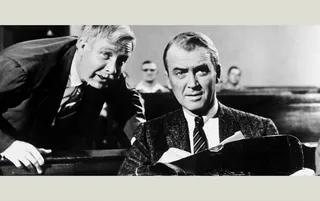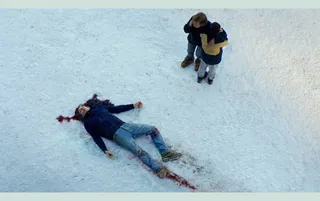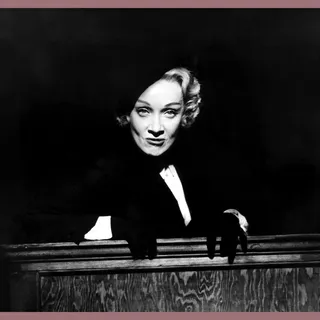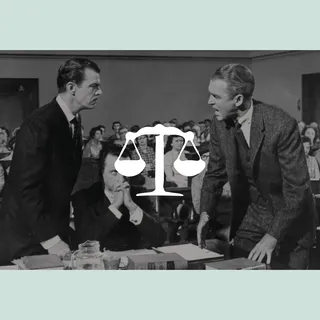Jury Duty
By Francine Prose
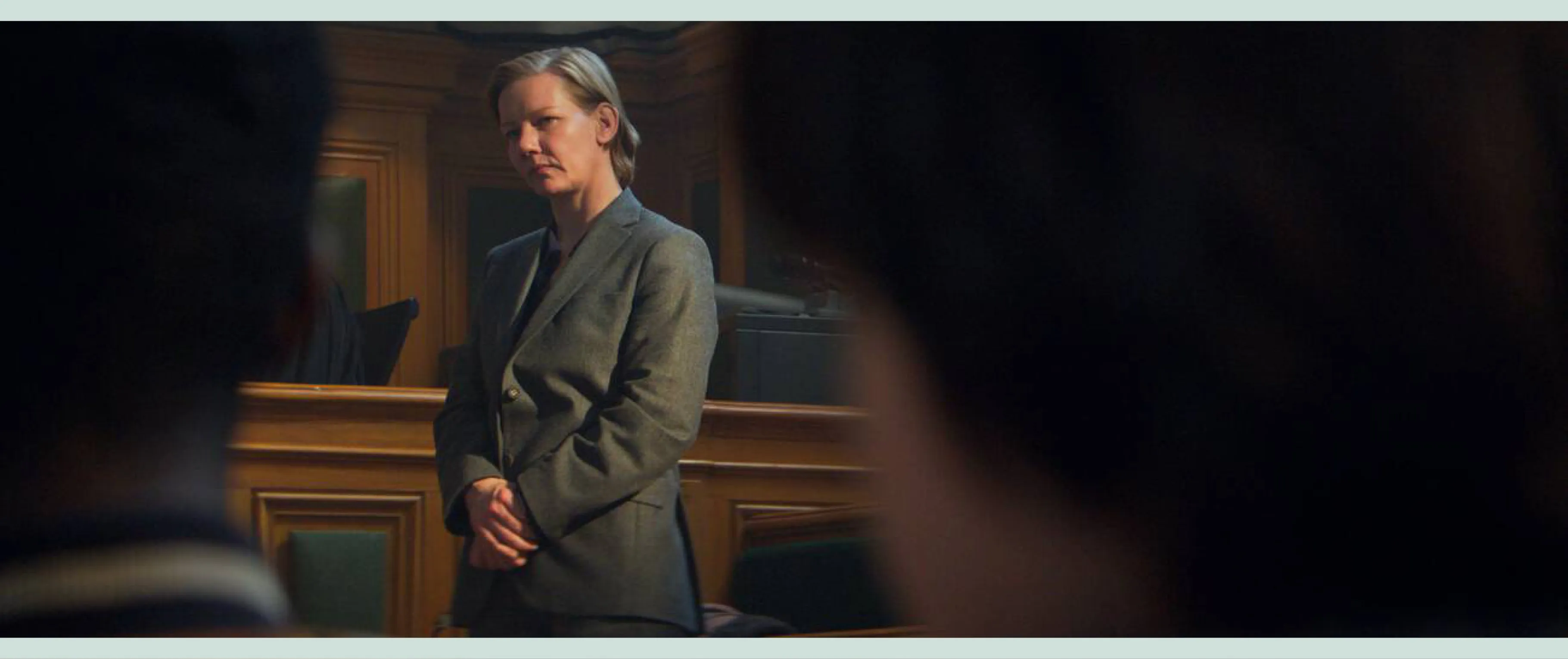
Anatomy of a Fall, dir. Justine Triet, 2023
Jury Duty
Dissecting the fraught moral dilemmas of the classic courtroom genre
By Francine Prose
July 10, 2024
I was 13 when my parents, my younger brother and I saw Otto Preminger’s 1959 film Anatomy of a Murder at a drive-in theater in Lake Placid, New York. My parents knew that one of the film’s principal roles—the judge presiding over the trial—was played by one of their heroes: lawyer turned actor Joseph N. Welch, who in “real life” had recently ended the terror-reign of Senator Joseph McCarthy with one sentence. Have you no sense of decency, sir? What they apparently didn’t know was that at the center of the trial in the film was a rape; that the rape victim (Lee Remick) exuded outrageous pinup sex appeal; and that a critical piece of evidence was a pair of ladies’ panties.
![]()
Arthur O'Connell and James Stewart in Anatomy of a Murder, dir. Otto Preminger, 1959
![]()
Samuel Theis, Sandra Hüller and Milo Machado-Graner in Anatomy of a Fall
Rape! Sex! Panties! This was the 1950s. There were kids in the car! Wasn’t there some way to cover their eyes and ears? From the back seat, I watched the film through a kind of haze generated by my parents’ discomfort. But that haze soon dissipated and I was fully there, at the trial, as I have been whenever I’ve watched the film since.
Shot in black and white, masterfully scored by Duke Ellington, the film—plenty of noir, a dash of Preston Sturges, a pinch of Cassavetes—is so artful with its familiar tropes that we forget they’re familiar. Jimmy Stewart plays Paul “Polly” Biegler, the (news flash!) awe-shucks country lawyer in a sleepy Michigan lake town with steel-trap intelligence and a calculating guile passing as goofy improvisation. Lee Remick pairs the helplessness of a drowning victim with knockout sexual power as Laura Manion, the deeply sad young woman who believes that her beauty and sexiness are the only things she has—and it’s not enough to save her. We’ve met men like the guy Ben Gazzara plays: Lieutenant Frederick “Manny” Manion, the controlling, hot-tempered spousal-abuser trying to convince the court that he was temporarily insane when he shot the guy who raped his wife.
Sex and death were all that was needed to ensure my preteen interest. But what kept me laser-focused then, and what has left me such a fan—of the film in particular and of courtroom drama in general—is the intensity of the trial, its structure, the moral dilemmas it poses and the ways in which directors, screenwriters and actors have decided to ask and answer essential questions of guilt and innocence, honesty and deception.
Watching courtroom dramas is like jury duty, only better. Without the tedious patches and boring recesses that can slow an actual trial, onscreen trials move right along—one skirmish, one revelation, one evasion or confession after another. We are invited to decide what is true, an invitation or requirement that few movies offer or demand. Then we must compare our conclusion against 12 other peoples’ and perhaps rethink our decision in whatever new light the director and screenwriter have decided to shed on the case.
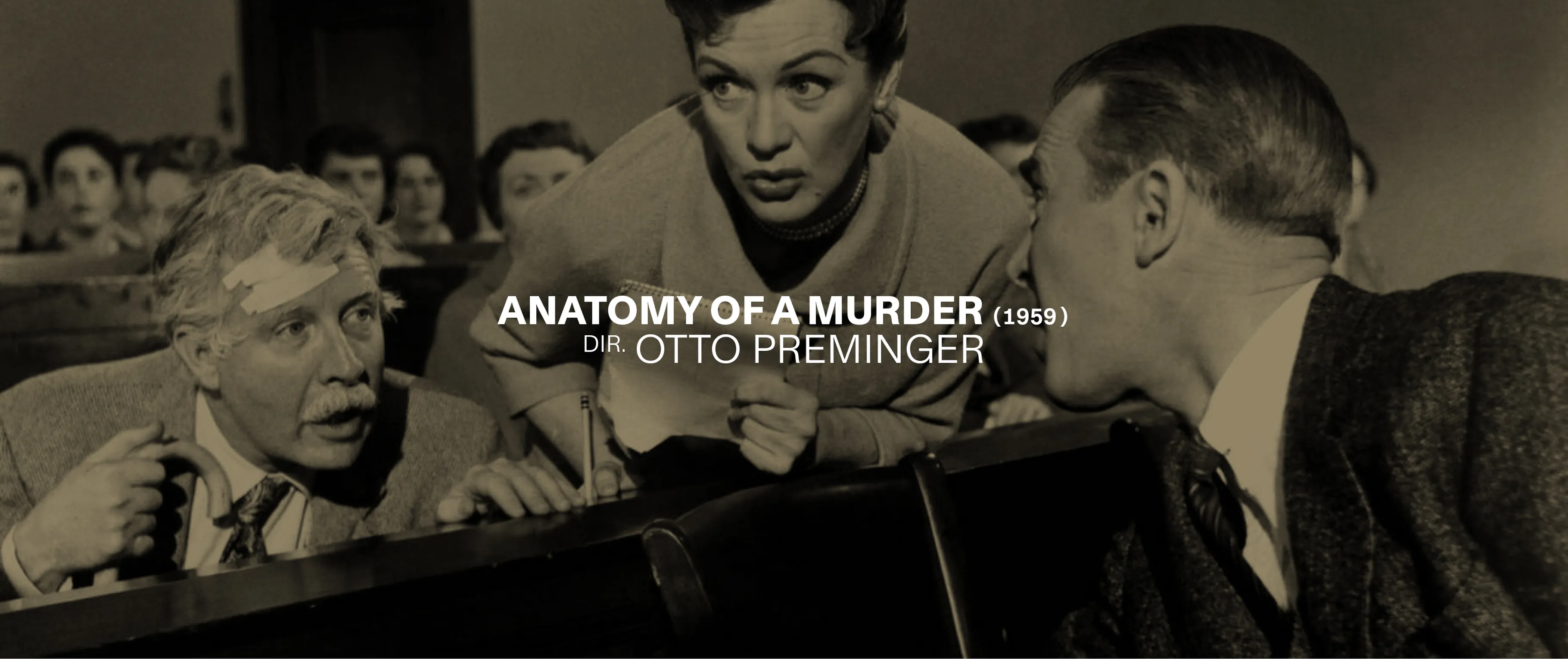
What’s involved is a moral decision, a biblical one. Despite moments of levity, it’s all deadly serious. If it wasn’t important, we wouldn’t be in a courtroom. A writing workshop cliché: What’s at stake in this story? In a courtroom, plenty is always at stake: money, a child, incarceration, life and death. And the best thing is that it’s not real. That is, it’s finally not our decision. We will not, as a real jurist might, be forced to live with our doubts, our certainties and second thoughts for the rest of our lives.
Sometimes secrets are badgered or tricked out of a witness. Or revelations may depend on information discovered in the world outside the courtroom. This requires another parallel cinematic narrative: the detective story. What can be found beyond the courthouse that will drastically change the outcome of the trial? All the time that the lawyers are preening and pouncing like big cats in Anatomy of a Murder, Polly’s amanuensis, Parnell—the great character actor Arthur O’Connell, playing the washed-up, geriatric, alcoholic former lawyer, a type we’ve also met before—is doing the legwork, finding out an all-important new fact.
If matters of guilt or innocence, life or death, aren’t enough to keep us engaged, there’s the gladiatorial battle of lawyer vs. lawyer. Even those viewers who don’t like conflict, boxing, violence or even cooking competitions can’t get enough of the defense and the prosecution slugging it out, talking over each other, standing, sitting, objecting and refuting.
Preminger combined the obvious and the inspired when he cast Stewart as the former local prosecutor voted out of office, so laid-back he’s fine with semi-retirement, fishing and playing jazz piano but crafty enough to charm the judge with guy-chat about frog flies. It was a brilliant decision to play him against (the young) George C. Scott as Claude Dancer: a slick, chiseled, angular, high-functioning prosecutorial machine brought in from the big city (Lansing!) to put Manny in jail, which is probably where he belongs. Dancer is sexist and aggressive, a common problem among unpleasant onscreen lawyers. The two men must pay attention, keeping track of each other’s every move, and so must we. There’s a thrilling moment when they fight about language: Dancer calls Laura’s solitary late-night rambles prowls; Polly objects to the term and they settle on walks.
“We are invited to decide what is true, an invitation or requirement that few movies offer or demand.”
In the courtroom drama witnesses take the stand and leave, but lawyers, bad and good, remain in high gear, becoming the default stars. Almost always, one engages our sympathies; we’d like to see the other lose. Part of the pleasure of Justine Triet’s 2023 drama Anatomy of a Fall, a title surely meant to evoke Preminger’s classic, is in watching two lawyers with competing styles perform in a French courtroom. Swann Arlaud (Maître Vincent Renzi), counsel for the defense, exudes charm, honesty, sympathy, a calming presence gifted with elfin, slightly androgynous good looks. By contrast, his opponent (Antoine Reinartz) seems possessed by a bullying, twitchy, weirdly fetal rage. Like George C. Scott’s Dancer, he is insinuating and puritanical, and he has, we sense, a low opinion of women.
Unlike so many narratives that prepare us for an unresolved ending, courtroom dramas promise a resolution. The truth will out, during (or sometimes even after) the trial. Friends who didn’t like Anatomy of a Fall cite their dissatisfaction with finally not knowing whether the victim was murdered or committed suicide. We’ve been so lulled and reassured by the clear resolutions that conclude most courtroom films—whether justice is served at the end of the trial, as in Sidney Lumet’s The Verdict (1982), or whether a final twist subverts the jury’s decision, as in the 1985 thriller Jagged Edge—that we’re confused and disquieted by an open ending.
A twist comes at the end of Anatomy of a Murder. Near the end of the film, there’s a seismic shift partly set off by the fact that Dancer can’t see beyond his macho view of women. And then there’s yet another turn: Polly discovers something after the trial that confirms but doesn’t change what we’ve suspected all along.
I can’t remember if, the first time I saw the film, I was surprised by the ending. I don’t think I was. If I wasn’t, maybe it was because I’d already seen a courtroom drama in which, at the end, the rug is, as they say, pulled out from under our feet.
![]()
Marlene Dietrich in Witness for the Prosecution, dir. Billy Wilder, 1957
![]()
Brooks West, George C. Scott and James Stewart in Anatomy of a Murder
That film was Billy Wilder’s marvelous adaptation of the Agatha Christie play Witness for the Prosecution. The film appeared in 1957, and I saw it with my aunt in a theater—one of the several movie palaces in my Brooklyn neighborhood—so I must have been 10 or 11. I don’t know how often I’ve seen it since, but when I watched it a few nights ago, I was struck by how accurately I remembered every detail: The monocle that the elderly barrister (Charles Laughton) angles to beam light into the face of a prospective client, a test somehow designed to divide the dishonest from the truthful. The lift designed to propel the ailing Laughton up the stairs in his home, the nitroglycerin pills (prescribed to protect his heart from overexcitement) he arranges into rows on his desk during the trial.
The accused, Leonard Vole (Tyrone Power) has been charged with murdering a silly, infatuated older woman for her money. Power doesn’t have much to do besides making anguished faces and flailing about in his box during the proceedings. Marlene Dietrich, as Christine, Vole’s ice-princess German war bride who happens to be his only alibi, steals the movie, and the great Billy Wilder is smart enough to let her have it.
Entering the courtroom Dietrich slices through space. The light knows exactly where to find her. We believe everything she says, all of which she delivers with a confidence and bravado that must have seemed almost freakish in a woman in 1957. She is the dream hot trophy wife, brought home from the war. She’s not only beautiful but streamlined, like a very expensive imported car. We think one thing about her, then another, and then—surprise—another, and she is a good enough actor to make us believe each new version of herself. She is the pivot on which the film turns, even as our sympathies are engaged by Laughton and his humorous battle with his bossy nurse (Elsa Lanchester), hired to keep him alive, meaning: no fun, no cigars, no brandy.
If there is a message in these films, it may be: No one is who they seem. Don’t trust first impressions. I probably would have figured that out on my own, sooner or later. But courtroom dramas provided a quick mini-education—what we fail to perceive, how subjective judgment is—that is part of what fascinates and inspires novelists. Something about fiction mimics the trial process: the opportunity to find out who someone is, their version of what happened. And to test it against what we intuit, what remains unsaid.
What happens onscreen changes the characters—and by extension, us. At the end of the courtroom drama, something has been revealed. Something had been decided. One or possibly several conclusions have been reached, and we the audience, we the jury, are excused to go home. It’s always a little sad to leave, because the courtroom has stood in for something larger than itself. It’s offered some promise of order, even if we know that the rule of law has been broken and betrayed by a jury of one’s peers.
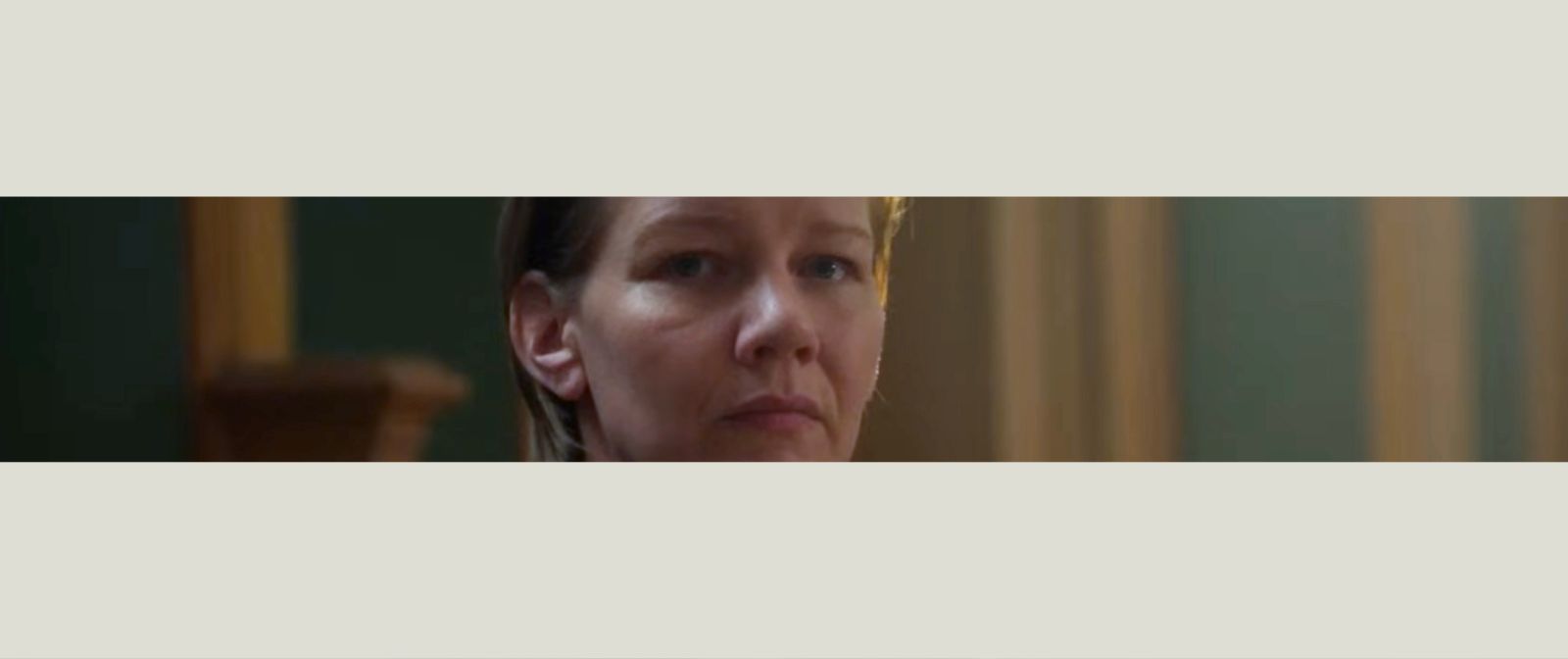
Sandra Hüller in Anatomy of a Fall
Near the end of Anatomy of a Murder, Polly’s sidekick, Parnell—the old geezer whose snooping has partly broken the case—has decided to mend his ways and perhaps rededicate himself to the law; it’s notable how many courtroom drama end up the up with the lawyer discovering a new sense of purpose. In any event, Parnell, tilting back in his chair, delivers a spontaneous hymn to the mystery and beauty of the jury system.
“Twelve people go off into a room: twelve different minds, twelve different hearts, from twelve different walks of life.… And in their judgment, they must become of one mind—unanimous. It’s one of the miracles of Man’s disorganized soul that they can do it, and in most instances, do it right well. God bless juries.”
Maybe it’s because of speeches like that, of ideas like Parnell’s, that we remain transfixed by courtroom dramas. Parnell’s words—Parnell’s faith—have been extraordinarily helpful lately when I’ve read the news about Donald Trump’s trials in Lower Manhattan. It’s comforting and reassuring to have Parnell remind me that the trial is not just a circus staged for our entertainment, but rather an attempt—admittedly imperfect, but so far the best we have—to ensure that justice is done.
